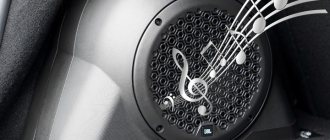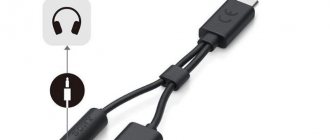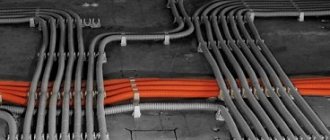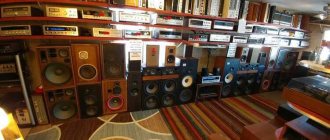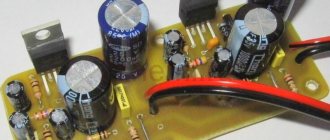Car amplifiers take the signal from the head unit, amplify it, and transmit it to the speakers. This allows you to get more powerful and clearer sound from the speakers than if the signal were supplied directly from the signal source to the speakers. Ideally, if the amplifier transmits the signal linearly - the output signal has the same shape as the input, only with a larger amplitude, which determines the sound power. This transmission of the signal form is called frequency response - amplitude-frequency characteristic, which shows how the amplifier transmits a signal at different frequencies. The smoother the frequency response, the better for signal quality.
Amplifier types
Manufacturers continue to create new types of amplifiers, but there are three main types of amplifier circuits: Class A, Class AB, Class D.
- Class A has a soft sound, but it is not efficient and overheats a lot.
- Class AB works much more efficiently in terms of efficiency, but the sound will be ordinary, neutral.
- Class D amplifiers are the most efficient in terms of energy loss, but they have a low damping factor, which shows the degree of attenuation of parasitic oscillations and depends on the output impedance of the amplifier.
Amplifiers are usually made with 5 or 4 channels, stereo 2 channels or monoblocks with one channel for connecting a subwoofer. Some manufacturers produce amplifiers with a large number of channels, but they are much less used in car audio systems.
Advantages and Disadvantages of Class D Amplifiers Compared to Class AB Amplifiers
Table of contents
Advantages of class D amplifiers: 1. Introduction: the operating principle of class D amplifiers and their main advantage is high efficiency
2. No step distortion
Disadvantages of Class D amplifiers:
3. Dependence of frequency response on load resistance
4. Reduced damping coefficient, the possibility of radio interference emission, sources of nonlinearity, the possibility of interference from the power source
5. Results and conclusions
Introduction: the operating principle of class D amplifiers and their main advantage - high efficiency
The idea of creating class D amplifiers was born in the USSR back in 1951 (Wikipedia).
But this turned out to be exactly the case when the path from idea to large-scale production turned out to be very long, several decades.
The reason for this was the lack of a suitable element base for this.
In fact, such amplifiers turned out to justify their idea only if high-speed MOSFET transistors with low channel on-resistance are used in the output stages; decades passed before their creation.
(simplified block diagram of a Class D amplifier with SE (Single Ended) output, image from Wikipedia, by Yves-Laurent)
In this mode (class D), the main advantage inherent in the idea of such amplifiers is maximally realized: high efficiency.
Output transistors in class D amplifiers operate in pulse mode and can be in two states:
- the transistor is closed, there is a high voltage on it, but zero current;
- the transistor is open, it has a low voltage, but a high current.
In both states, the power dissipated by the transistor is low, in contrast to class AB amplifiers, where operation in the “high current and high voltage” mode on the output stage transistors is typical.
The formation of the analog signal itself is carried out using pulse-width modulation (PWM), and then the resulting voltage is smoothed by a filter and takes on a form suitable for reproduction (a filter is not always required).
The following oscillogram shows the voltage at the output of the D-class amplifier (TDA3255 chip) before the filter (PWM) and after the filter. Amplifier operating mode - SE (Single Ended, i.e. not bridged):
(image from a review of a Class D amplifier with 2.1 configuration on the TPA3255 chip)
The PWM frequency in most common D-class amplifier microcircuits is set by an internal oscillator and is 400 kHz - 1.2 MHz.
In class D amplifiers (class D in Russian spelling), the efficiency can reach 90% or higher.
The main source of losses is the “residual” voltage on the output transistors in the open state: it is small, but it still exists and, in combination with a high current, can dissipate up to 10% of the power taken from the power source (typical loss is about 5% ).
High efficiency is accompanied by other advantages of class D amplifiers, resulting from the fact of high efficiency.
Firstly, such an amplifier requires much less heat dissipation than class AB amplifiers. With an output power of up to 10 Watts, as a rule, no heat sink is required at all (sometimes up to 15 Watts).
Secondly, the dimensions and weight of amplifiers are reduced.
Thirdly, when used in self-powered devices, battery life increases.
No stair-step distortion
In addition to high efficiency, class D amplifiers completely avoid the disadvantage of class AB amplifiers such as step-type distortion.
In class “B” amplifiers, such distortions are formed due to the fact that when the signal passes through zero in the output stage, the upper arm turns on later than the lower one turns off. As a result, the signal “hangs” at zero for some time:
In class “AB” amplifiers, such signal distortion is reduced due to the circuitry “bringing together” the levels of the upper and lower arms so that they slightly intersect.
In modern “AB” class low-frequency power amplifier microcircuits, this effect can be noticed only at high frequencies and in a very specific form: there one of the half-waves of the signal may “ring” due to the asymmetry of the transistors in the output stage.
This is what this effect looks like in the TDA2050 chip at a frequency of 200 kHz (!):
(image from TDA2050 amplifier review)
The frequency of the “ringing” goes far beyond the audibility of the human ear; but music lovers argue that this effect still spoils the sound, and truly high-quality sound can only be achieved with tube amplifiers.
In class D amplifiers, this effect cannot exist in principle, since the transistors of the output stage operate in the key mode and the moment of transition through zero is extremely short.
Disadvantages of Class D amplifiers
So, we’ve sorted out the “advantages” of class D amplifiers.
It's time to tackle the downsides too!
1. The amplitude-frequency response (AFC) of class D amplifiers depends on the load resistance and its nature (active or active with an inductive component).
The reason for this is elementary. If you look again at the amplifier output filter diagram (at the beginning of the article), you will see that it is essentially an oscillating circuit.
When connecting a low-impedance active (i.e. resistive) load, the resonance is suppressed and is not noticeable. But when the load resistance increases and/or an inductive component is added, it becomes clear.
For comparison, let’s look at the frequency response of a class D amplifier based on the TDA7498 chip (review) with a resistive load of 8 Ohms; and then - completely without load.
The frequency response was measured by applying a signal with a linearly increasing frequency to the input of the amplifier; and then an oscillogram was recorded, taken from the signal maxima. It represents the frequency response of the amplifier (circled in the image with a red frame, followed by a repetition of the signal cycle with increasing frequency).
So, the frequency response of a class D amplifier with a load of 8 Ohms in the range of 10 Hz - 20 kHz:
Now - the frequency response of the same amplifier without load in the same range (10 Hz - 20 kHz):
Without load, the frequency response begins to rise sharply as it approaches the self-resonance of the LC filter at the output of the amplifier.
2. The damping ratio of Class D amplifiers is lower than that of Class AB amplifiers.
The damping factor is the ratio of the load resistance (speaker system) to the output impedance of the amplifier (which also includes the resistance of the cable from the amplifier to the speakers).
The higher the damping coefficient, the better the suppression of parasitic resonances in the speaker system; and the more qualitatively the sound can be reproduced.
In class AB amplifiers, due to negative feedback (coming directly from the output), their output impedance of the amplifiers can be made arbitrarily close to zero over the entire operating frequency range.
In class D amplifiers, there are filters at the outputs that do not participate in the feedback circuit, and there the damping factor cannot be as large as in class AB amplifiers.
Filters have both ohmic resistance and inductive resistance, which increases with frequency.
The ohmic resistance of the filter is very small, less than 0.1 Ohm. But if the amplifier design is unsuccessful, it can increase due to heating (~0.4% per degree). Heating occurs both due to heat transfer from other elements, and due to “self-heating” when current flows into the load.
The inductive reactance (impedance) of filters increases in direct proportion to frequency according to the formula XL = 2∏fL, where f is the frequency, L is the inductance, XL is the impedance.
For example, for the TDA7498 microcircuit, according to the datasheet (PDF), it is recommended to install an inductance of 22 μH (microhenry) in each arm of the bridge output; total total inductance is 44 μH.
The impedance will be:
1 kHz - 0.28 Ohm,
5 kHz - 1.38 Ohm,
10 kHz - 2.76 Ohm,
20 kHz - 5.53 Ohm.
For frequencies above 1 kHz, the impedance of the filters can no longer be neglected.
There are also D-class amplifiers without filters. In this case, the speaker's voice coil acts as a filter.
This construction of D-class amplifiers is allowed if the power is not high (usually up to 5 Watts), and the length of the wires to the speakers (speakers) is short; and the radio interference generated in this case will be weak.
Theoretically, one could write down the increased level of radio interference from amplifiers as a separate disadvantage, but in practice radio interference occurs only in cases of gross errors in the design of amplifiers.
For example, this is possible in cases where a powerful amplifier is designed without filters.
In this case, the cable running from the amplifier to the speakers turns into a high-quality radiating antenna; and thanks to the steep pulse fronts, not only the fundamental PWM frequency is emitted, but also many dozens of harmonics.
3. The linearity of Class D amplifiers may be worse than that of Class AB amplifiers.
This is because there is a ramp voltage generator inside the amplifier, which the input voltage is compared to to generate PWM output pulses. If the generated sawtooth voltage has nonlinearities, they will be directly transmitted to the input.
Another possible source of nonlinearity is the output LC filters (if available). Both inductances and capacitances can be nonlinear; but this applies more to inductances (depending on the quality of the ferrite used).
4. Interference from the power supply may be transmitted to the output
Typically, Class D amplifier ICs have noise suppression systems from the power supply; but due to the physical principles of operation of Class D amplifiers, such suppression cannot be complete.
This is due to the fact that the output key transistors, during the time they are in the open state, actually close the amplifier output to the power source. During this time, noise from the power supply goes directly to the output. The countermeasure is obvious: improving the filtering of the supply voltage.
Results and conclusions
Class D amplifiers have made a small revolution in amplification technology, but only in terms of efficiency and its consequences, i.e. the possibility of reducing the size of sound-reproducing devices and increasing the duration of their autonomous operation (if necessary).
In terms of sound quality, no revolution has occurred. If it has changed, it has changed very little and not for the better.
Some “plus” of class D amplifiers in terms of sound quality (in the form of complete elimination of “step” distortion) is unlikely to be noticeable when compared with modern high-quality class AB power amplifier microcircuits.
But, at the same time, the negative effects associated with an increase in output impedance at high frequencies are unlikely to be noticeable when working with a fixed load in the form of fairly high-quality speaker systems.
The final result: the improvement in efficiency (with its listed consequences) can be considered the main and only change in the operation of class D amplifiers compared to the “good old” class AB amplifiers.
Additional materials
:
— Reviews of single-board class D amplifiers
— Reviews of class AB single-board amplifiers
Join the SmartPuls.Ru Contact group! Announcements of articles and reviews, current events and thoughts about them.
Your Doctor
.
Recommend this page to your friends and classmates.
As usual, flooding, flaming and off-topic topics are prohibited in the comments. It is also prohibited to violate generally accepted norms and rules of behavior, including posting extremist appeals, insults, slander, obscene language, or promoting or approving illegal actions. Compliance with laws is in your best interests!
Comments on VKontakte:
FaceBook comments:
When copying (reprinting) materials, an active link to the source (SmartPuls.ru website) is required!
How an amplifier works
There is nothing important about the operating principle of the amplifier that can be useful to the user. This information is more suitable for enthusiasts who ask themselves questions about how an amplifier works and how it controls the signal. We won't delve into circuitry, the history of transistors, or how transformers work, but rather what an amplifier does with the signal it receives from the head unit and carries that signal through its paths.
It is commonly thought that an amplifier takes the original small signal and increases it to a certain amount. This is only partly true; in fact, the amplifier creates a new signal that should be an exact copy of the input signal.
Let's compare an audio amplifier and a copy machine. You're probably wondering how these two different technologies compare. But if you have made a copy on a copier, then you have noticed that you can use it to enlarge the original document by a certain amount. If you have the original image and enlarge it to different sizes, you will have two identical images of different sizes, but on different sheets of paper. The new image is a large copy of the old picture, that is, it is a new sheet with its own image. Now let's transfer these operating principles to an amplifier. It takes the signal from the input and outputs an already increased signal. However, the output signal, like a copier, is not the same as the input. The signal increases only in amplitude, but not in the length of the sound wave, otherwise there will be interference and distortion of the signal and an exact copy will not be obtained. This analogy should give you a general idea of how an amplifier works.
An amplifier takes a weak signal from a source, such as a CD player, and boosts it to make the speakers work properly. And although these are not the same signal, the only difference between them is their power.
What else to look for when choosing an amplifier
Let's consider what points you should pay attention to in order to choose a sound amplifier with the optimal ratio of functionality, price and quality.
- Device cost. The low cost should alert you. You should not buy inexpensive devices.
- The area of the room where the amplifier will be installed. This affects the sound quality. It should be taken into account that the power per channel is 3-5 watts per square meter. If the parameters do not exceed fifteen square meters, then the first figure must be taken into account; for areas greater than twenty square meters - the second.
- Buy devices from companies and stores where it is possible to check the quality of the device in action.
- It is necessary to select equipment with a power reserve, since the devices should not be used at maximum power. All this can affect the service life of the device. The most reliable amplifiers are considered to have a power of up to one hundred watts.
- If possible, you should choose equipment from the same manufacturer. In cases where this is not possible, try to choose a device of the same class.
Distinctive features of the amplifier design solution
Audio frequency amplification systems include a pre-amplification system and a signal power amplifier. The pre-system is used to increase the signal power to the parameters required for the operation of the main amplifier. The preamplifier includes timbre and volume control systems or an equalizer. It can be part of the main amplifier or run as a separate device.
The task of the main amplifying device is to generate a signal of the required power and transmit it to the load circuit, which may include various devices for emitting sound waves:
- speakers,
- headphones,
- broadcast network,
- modulator system, etc.
It should be noted that sound amplifiers have become an integral part of any sound recording/reproducing or broadcasting equipment.
Do you need a speaker amplifier in a car and choosing a place for it?
Having decided for yourself positively the problem of whether a speaker amplifier is needed in a car, you need to think about where it will be located. Since such a device heats up when working, you need to allocate a place where the device can function without cooling. Otherwise you will have to use coolers. By placing the equipment on the back of the seat, on the trunk trim, or on the rear shelf, no additional device is needed.
Watch a video about choosing a budget audio system for a car.
You should not fix the amplifier far from the acoustic system, and when installing it, you need to make sure that the influence of other components that are present in the car does not affect its operation.
Amplifier installation methods
Having listened to how music sounds in a car that has a four-channel device, its owner will no longer wonder what a car speaker amplifier is for . The difference in acoustics is amazing.
Having purchased equipment with suitable parameters, you need to decide on the installation method. The easiest way is to mount the device on a surface. There is no need to purchase an additional stand if it is located in a place such as a shelf or front seat and will not spoil the design inside the car.
Otherwise, you will have to hide the wires, for which a false panel is made. The amplifier will be located on an open surface, and there will be no need for a cooling device. In the interior space, installation is usually carried out by specialists, since they will be able to install the equipment without disturbing the interior.

